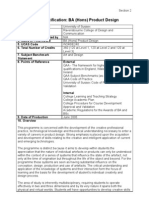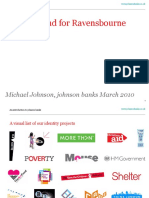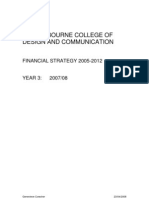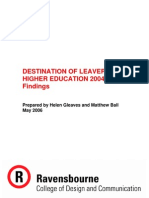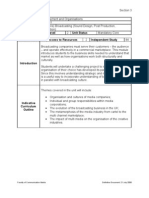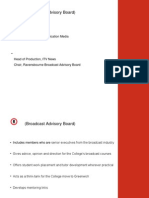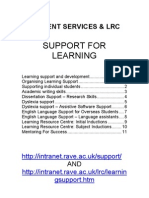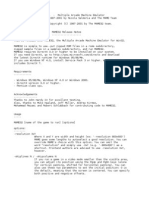Programme Specification: BA (Hons) Interior Design Environment Architectures
Uploaded by
lisaconnollyProgramme Specification: BA (Hons) Interior Design Environment Architectures
Uploaded by
lisaconnollySection 2
Programme Specification: BA (Hons) Interior Design
Environment Architectures
1. Awarding Institution University of Sussex
2. Teaching Institution Ravensbourne College of Design and
Communication
3. Programme Accredited by N/A
4. Name of Final Award BA(Hons) Interior Design Environment
Architectures
5. UCAS Code W250/E250
6. Total Number of Credits 360 (120 at Level 1, 120 at Level 2 and 120 at
Level 3)
7. Subject Benchmark Art and Design
Statement Architecture
8. Points of Reference External
QAA - The framework for higher education
qualifications in England, Wales and Northern
Ireland
QAA Subject Benchmarks (as above)
QAA Code of Practice
University of Sussex Code of Practice for
Validation
ARB guidelines
Internal
College Learning and Teaching Strategy
College Academic Plan
College Procedure for Course Development
Approval and Validation
Academic Regulations for the Awards of BA and
BSc
9. Date of Production June 2005
10. Overview
This programme is concerned with the development of the creative professional
practice, technological knowledge and theoretical understanding necessary to enter a
variety of careers in the area of interior design and architecture. The broad aims of
the course are to provide a creative education for architectural environment
designers, which fits with the vocational needs of industry and also provide a rigorous
intellectual examination of the issues surrounding built form.
The course is unique in that it combines virtual design and interior design with design
in architecture and develops an understanding of the polycultural nature of
environment design and the contemporary socio-political flux which determines the
need for permanent, temporary, and virtual habitation. It integrates the study of
history, theory, construction and technology, the acquisition of multidisciplinary two
and three dimensional spatial skills, and interaction as it relates to the design and
notion of habitations in the form of physical and virtual environments and related
artefacts.
Faculty of Design 1 Definitive Document: 21 July 2006
Section 2
Students will have opportunities to develop and understand design propositions as
they relate to existing and proposed inhabited form, interactive spaces, urban design,
sustainable communities and micro environments. These creative and professional
skills will be reinforced by a comprehensive contextual, technical, and theoretical
understanding of the forces driving the experience and development of built and
inhabited form.
The three principal areas of study over the three levels will concern: the design of
and intervention in existing spaces, their rehabilitation and extension; the creation of
new built environments; and the design of virtual spaces for representation and
interaction.
In Level 1, the course deals with the design process and the underpinning skills and
theory. Curriculum areas introduced in this level may include; design skills and
methodologies, structures and materials, computer technologies and CAD,
computation in the design process, two and three dimensional communication and
representation, the history of architecture and interior design, context as a vehicle for
spatial development, precedent and theoretical studies and cultural studies.
In Level 2 of the course, the experience shifts towards interpretation and the
application of the skills acquired in Level 1 in the creative process. Students
experience a variety of increasingly challenging projects that introduce the
commercial aspects and the complex compound of polycultural factors which
influence the nature of environment design in a contemporary context. This is
integrated into the design process at this level. Curriculum areas may include; urban
environment design and its impact, the regulatory framework, production of detail in
the design process, advanced computation and market factors. In the first and
second level, some of projects will be conducted in collaboration with students from
other courses.
In Level 3, students develop individual, independent lines of enquiry which build on
the practical and theoretical elements in the first and second level through the
medium of an agreed self-initiated project. In addition, students will independently
research and prepare a dissertation. Students will also have the opportunity to enter
national and international design competitions and create a professional portfolio
which will take them from the academy into the world of work.
Faculty of Design 2 Definitive Document: 21 July 2006
Section 2
11. Educational Aims of the Programme
The course aims to provide graduates with the knowledge and skills appropriate to a
range of career outcomes in interior design. Students are encouraged to develop
their individual creative ability and support this with the development of a high level of
technical skills. In particular, the programme aims to enable students to develop:
• a range of creative, technical and professional skills relevant to employment in
interior design and related areas;
• an understanding of the key critical, social, cultural, historical and business
concepts, issues and debates relevant to the area of interior design;
• a comprehensive knowledge of contemporary professional practice and the
creative process in the professional field in which they will specialise and an
awareness of current areas of development and innovation;
• the ability to make creative use of and experiment with new and existing
technologies;
• a clear vision of where their creative strengths lie and how this can be utilised
in product development and potential career opportunities;
• skills in research, analysis, problem solving and critical reflection and the
visual, written and verbal communication skills required of a graduate entrant
to the interior design industry;
• initiative and personal responsibility, experience of collaborative working
methods and the ability to be responsive and adaptable to changing needs,
and the transferable skills and competencies which enable life-long learning.
Faculty of Design 3 Definitive Document: 21 July 2006
Section 2
12. Intended Learning Outcomes - This programme provides opportunities for
students to develop and demonstrate knowledge and understanding, skills, qualities
and other attributes in the following areas:
KNOWLEDGE & UNDERSTANDING
A - Knowledge and Understanding of: Teaching and Learning Methods
1. the design process in general and Learning and teaching in relation to these
specifically in interior design and learning outcomes tends to be primarily
architecture project based (see Practical and
2. three-dimensional form and the Professional Skills below). This is
processes that determine and govern the supported by varied learning and teaching
development and creation of form methods which may include as
3. the nature of representation within the appropriate: project briefings, studio
sphere of two and three-dimensional form based lectures, (staff and student led)
4. contemporary inbuilt form practice and group seminars, technical or practical
theory workshops, demonstrations, critiques,
5. the depth and breadth of the individual or group tutorials and self
technologies upon which the discipline of directed study by the student.
architecture, interior and environment
design is based Learning is facilitated by well qualified
6. the nature of human form and thought permanent teaching staff and by sessional
processes and the consequences for staff and visiting speakers who are
architectural form and designed artefacts practising professionals and bring an
7. computation in design and its application important industry perspective to the
8. the analysis of function and its role in course. Traditional modes of delivery may
constructed environments be supported where appropriate by e-
9. the creative potential of digital learning and/or resource based learning.
technologies
10. how creative professional practice in Contextual and theoretical learning are
general and interior and architectural design delivered both as an integral part of the
in particular is located within historical, practice based units and separately in a
social and cultural contexts progressive series of mandatory cross-
11. the nature of technological change and College units. This prevents a
the development of knowledge theory/practice dichotomy while ensuring
12. key professional skills necessary to that this aspect of learning is sufficiently
underpin graduate employment in the weighted in the curriculum.
creative industries
13. the integrative relationship of structure, Assessment Methods
materials and construction
14. the production of sustainable design Knowledge and understanding is primarily
assessed through essays, reports and
individual and group presentations, and
through its application in practical projects
in a manner appropriate to each unit of
delivery. Some units additionally require
the submission of rationales, background
research, development materials and/or
evidence of reflection on the project
process.
Faculty of Design 4 Definitive Document: 21 July 2006
Section 2
SKILLS AND OTHER ATTRIBUTES
B - Practical/Professional Skills – Able Teaching and Learning Methods
To:
Professional and practical skills are gained
1. demonstrate an understanding of the primarily through self-directed project
skills used by the various branches of based learning.
architecture, interior and environment
design Supported by staff, students work on
2. create architectural designs that integrate project briefs designed to foster creative,
social aesthetic and technical requirements technical and academic skills while
3. use digital technology creatively as part progressively introducing professional
of the design process and as a tool for contexts and constraints. This approach is
presentation and communication student-centred, encourages deep
4. generate individual solutions in response learning, builds problem solving ability and
to a brief or an identified need integrates academic with professional
5. articulate design thoughts and concepts learning. Students learn to take
clearly, concisely and with accuracy by a responsibility for their own learning
variety of media progressively. Some projects are
6. respond to a broad constituency of intentionally collaborative encouraging
interests and to the social and ethical team working and peer learning. This may
concerns of the subject involve students from other courses.
7. work collaboratively within a
multidisciplinary environment Projects are supported by briefings,
8. be flexible and adaptable in the approach studio lectures, workshops, critiques,
to and the development of a solution to a group seminars and student self
problem or in responding to an opportunity directed study. Learning is facilitated by
9. plan architectural design project permanent teaching staff and by sessional
development exercising personal staff and visiting speakers who are
responsibility within the physical and time practising professionals and bring an
constraints of the brief important industry perspective to the
10. practically engage with the world of course. These methods may be supported
work, and analyse an existing work related where appropriate by e-learning and/or
construct resource based learning. The project
11. apply the conventions of architectural based approach culminates in
representation independently negotiated project work in
the final level of the course.
Assessment Methods
Practical and professional skills are
assessed primarily through their
application in project work submitted for
summative assessment. Some units
additionally require the submission of
rationales, background research,
development materials and/or evidence of
reflection on the process of development.
An individual or group presentation may
form part of the assessment requirements
of some projects.
Faculty of Design 5 Definitive Document: 21 July 2006
Section 2
SKILLS AND OTHER ATTRIBUTES (Continued)
C - Intellectual Skills – Able To: Teaching and Learning Methods
1. be intellectually curious, analytical and Intellectual skills are gained primarily
reflective, capable of carrying out sustained through lectures, seminars, workshops,
independent enquiry and develop the skills individual tutorials and self-directed
that underpin professional development and study but also through project based
life-long learning learning.
2. analyse problems and respond
reflectively, using innovation and lateral Students are introduced to a variety of
thinking in their solution research and analytical methods through
3. understand that the acquisition of the contextual elements of the course and
knowledge is continuous and ongoing apply them in an independent major study
professional and personal development is and the preparation of a dissertation in
essential the third level of the course. Project
4. work within a design process and to based learning stimulates analysis,
contribute to this contextual and visual research, problem
5. be entrepreneurial, imaginative, have solving, creative thinking and personal
divergent thinking skills and think creatively reflection.
whilst still satisfying the needs of the
project/client Assessment Methods
6. delineate the similarities and differences
between the interrelated disciplines of Students are primarily assessed through a
design, and form an understanding of their variety of means including essays,
interaction presentations and a dissertation. Some
7. creatively solve problems and issues that elements are assessed through their
are revealed during the generation of their application in submitted project materials.
work This may include rationales, background
8. place their own work critically in relation research, development materials and/or
to existing and emerging professional evidence of reflection on the process of
and/or academic debates and to form a development in addition to practical
personal creative critique material.
9. interrogate critically a brief and its cultural
and contextual assumptions and identify the
key opportunities, factors and issues
associated with it
10. analyse and interpret the nature of
forms and space and their depiction and
construction in two and three-dimensional
media and digital form
Faculty of Design 6 Definitive Document: 21 July 2006
Section 2
SKILLS AND OTHER ATTRIBUTES (Continued)
D - Transferable Skills – Able To: Teaching and Learning Methods
1. work independently, setting own aims, Students develop transferable skills
objectives and deadlines to manage primarily through self-directed project
learning, workload and projects, including activity, which progressively introduces
time, personnel and resources professional contexts.
2. work effectively and collaboratively with
others in a team from a variety of Though most learning takes place during
backgrounds and disciplines the projects and through students’ critical
3. manage information in a range of media, and reflective responses to these, this
selecting and using a variety of sources and aspect of learning is supported by a
technologies to evaluate and record/present Personal and Professional Development
information unit in each of the course levels. The first
4. articulate ideas and information in visual, level concentrates on ensuring that
oral and written forms, and communicate students ‘learn how to learn’. The second
ideas and work clearly and appropriately to and third levels focus on career planning
a variety of audiences, including technical and the development of professional
and non-technical audiences transferable skills to enable the student to
5. produce work that is literate, numerate make the transition to employment and/or
and coherent, deploying established further study.
techniques of analysis and enquiry
6. identify, define and creatively solve Assessment Methods
problems, using appropriate knowledge,
tools and methods, often in complex and Transferable skills are assessed within
unpredictable situations appropriate units throughout the course,
7. demonstrate critical awareness and and in particular through the submission of
reflection through evaluating own strengths Personal and Professional Development
and weaknesses, and adapting proposals Files. These files (containing a learning
and plans accordingly plan, reflective commentary and evidence-
base) are developed within the Personal
and Professional Development unit and
provide evidence of work and learning
carried out across the course. For
instance, evidence of personal
development achieved through research,
design development and realisation;
responses to briefs; and evidence of
project management. Students are also
assessed through peer, group and self-
assessment.
Faculty of Design 7 Definitive Document: 21 July 2006
Section 2
13. Admission Criteria
Students will normally be expected to possess five GCSEs (grade C or above) or
equivalent and also to hold at least one of the following or equivalent:
• Diploma in Foundation Studies in Art and Design;
• National Diploma (in an appropriate subject area);
• Access to Higher Education (in an appropriate subject area);
• 2 A Levels;
• Double AVCE;
• 4 AS Levels;
• GNVQ Advanced.
Applications are positively welcomed from those who may not possess formal entry
qualifications, mature students, those with work experience or with qualifications
other than those listed above.
Students will be expected to attend for interview and submit a portfolio of examples of
work.
Students will be selected according to the criteria set out in the College Procedure
for the Admission of Students and Guidance Notes for Selecting Candidates for
interview.
When appropriate the College’s Accreditation of Prior Learning Policy and Procedure
will be used to assess applicants at interview. The key criterion for entry is evidence
of commitment and motivation to study in the subject area.
Faculty of Design 8 Definitive Document: 21 July 2006
Section 2
14. Assessment Regulations and Principles
In common with all Ravensbourne honours degree courses, this course is subject to
the Academic Regulations for the Awards of BA and BSc.
In summary, in order to complete a unit, a student must successfully complete all the
assessment specified for that unit. In order to progress from level one of the course
to level two or from level two to level three, a student must successfully complete all
the units in that level of the course. In order to achieve the award, a student (having
completed level one and two of the course) must successfully complete all the units
in level three. In certain circumstances, the Examination Board may at its discretion
choose to permit performance in one area to compensate for underachievement in
another subject to the provisions of the Academic Regulations for the Awards of BA
and BSc. However, there is no automatic right to such compensation.
The final degree is classified on the basis of the level three units only. Classification is
determined by the average of the final results achieved in each of the final year units
weighted by their credit size, according to the banding below:
Classification Grade Percentage Banding
First Class Honours A 100 – 70
Upper Second Honours B 60 – 69
Lower Second Class Honours C 50 – 59
Third Class Honours D 40 – 49
Pass E 35 – 39
15. Support for Student Learning
Learning and teaching on the course is supported by a specialist permanent teaching
staff and the inputs of sessional lecturers who are primarily practitioners and bring
with them the freshest perspectives from industry.
Students will be exposed to a wide range of different interactive environments,
technologies and techniques. Students on the course will have access to an
extensive range of College resources. These are set out in the current Ravensbourne
College Resources statement. Facilities pertinent to this course currently include:
• ILab Cave (7 workstations dedicated to interaction);
• Green Cave (15 workstation for 2D & 3D design and animation);
• Blue Cave (15 workstation for 2D & 3D design and animation);
• Purple Cave (15 workstation for 2D & 3D design and animation);
• College Wide General Computer Resource (Word Processing, Spreadsheets,
Graphics etc.);
• Learning Resource Centre (32,000 books, 10,000 hours off-air video recordings,
over 100 separate periodicals, plus an impressive range of electronic resources).
Support for students with learning difficulties and study support needs are in place
through the College Student Support Services.
Faculty of Design 9 Definitive Document: 21 July 2006
Section 2
16. E Learning
In addition to the aspects of the curriculum delivered in the traditional manner through
lectures, workshops and other face to face delivery methods, learning will also be
supported by the developing ‘Moodle’ Virtual Learning Environment (VLE). Course
Handbooks, project briefs and other course materials will be stored for retrieval and
access on or off campus. Similarly students are able to apply themselves to on-line
group forums and critiques and tasks at the time and place most suitable to their
personal schedules and commitments.
17. Indicators of Quality and Standards
The course operates within a College quality assurance framework which ensures
that the standards set at validation are maintained and enhanced and the quality of
the student learning experience is good. As part of this framework the course is
subject to the following processes:
• Course Review;
• Mapping against FHEQ and Subject Benchmark Statement during development;
• College Internal Validation;
• External Validation by the University of Sussex;
• External Examiner Reports;
• Annual Course Monitoring;
• Student Feedback;
• Student Representation;
• Peer Observation of Staff;
• Staff Training Programme;
• Industry collaboration (for specific projects);
• An advisory committee which ensures that the programme is up to date and in
line with the thinking and direction of the industry and professional world;
• Student competition/show entry.
18. Multidisciplinary Environment
Like all courses, working on projects with students from other disciplines is central to
the aims of this programme. Many of the projects in the BA (Hons) Interior Design
Environment Architectures programme will involve students working as team
members with students on other courses at Ravensbourne College of Design and
Communication. These may include BA (Hons) Broadcasting, BA (Hons) Content
Creation and Broadcast, BA (Hons) Design for Moving Image, FdA Broadcast Post
Production, BA (Hons) Design for Interaction, BA (Hons) Fashion and BA (Hons)
Product Design.
Faculty of Design 10 Definitive Document: 21 July 2006
Section 2
19. External Contexts
In line with the College’s aim of ensuring the continued commercial relevance of our
academic provision, the course actively collaborates with industry. Past ‘live’ project
partners have included Vitram, Olsen, Inspired Broadcast, Nokia and Audi
Foundation.
Recent student industry visits/trips have included Vitra hq-Basle, Barcelona, Design
Museum, Goldfinger House and Rotterdam.
Recent talks by visiting industry specialists have included Paul Brennan, Colin Titlow,
Vince Wade and David Fern.
Placement is not a compulsory part of the course and is not assessed. However,
students are strongly encouraged to undertake placement and are supported in this
by the College Employability Unit. Students have in the past achieved voluntary
placements at Fitch, Proof Design, FOA, Sledge, Household, David Chipperfield and
Brinkworth.
Students have in the recent past exhibited and participated in the London
Architecture Biennale, Zollverein- Design element of HM the Queen‘s State visit to
Germany and Tokyo Design Week.
Graduates of this course have entered a variety of careers including Architecture,
Interior Architecture, Interior Design, Virtual Games Design, Furniture and Product
Design and Exhibition Design. Graduates currently work with companies such as
HMKM, Gensler, HOK, Fitch, Branson Coates, Damond Lock Grabowski, S L Design,
Imagination, United Designers, David Pocknell Studio and DIN Associates.
Faculty of Design 11 Definitive Document: 21 July 2006
Section 2
20. Unit List
Level 1
Unit Code Unit Title Credit
Value
IDEA101 Communication and Representation 1 10
IDEA102 Specialist Study 1 10
IDEA103 Communication and Representation 2: with 10
Computer Technologies
IDEA104 Specialist Study 2 15
IDEA105 Computation 1: Parametric Systems 10
C102/IDEA106 Contextual Studies Elective 1 10
IDEA107 Specialist Study 3: Dual Use Environment 15
PPD1/IDEA108 Personal and Professional Development 1 10
C101/IDEA109 Design and Communication Media, Theory and 20
Context
D101/IDEA110 The Design Elective 10
TOTAL 120
Level 2
IDEA201 Urban Environment Theory and Practice 20
IDEA202 Computation 2 10
IDEA203 Market Factors 20
IDEA204 Rehabilitation and Reuse 20
IDEA205 Artefact and Element in Environment Design 10
C201/IDEA206 Know Your Audience: Society, Culture and Politics 10
C203/IDEA207 Contextual Studies Elective 2 10
PPD2/IDEA208 Personal and Professional Development 2 10
C202/IDEA209 Dissertation Preparation 10
TOTAL 120
Level 3
CAVE301/IDEA301 Negotiated Brief 20
IDEA302 Portfolio Development 20
IDEA303 Major Project 40
IDEA304 Major Project Report 10
PPD3/IDEA305 Personal and Professional Development 3 10
C301/IDEA306 Dissertation 20
TOTAL 120
Faculty of Design 12 Definitive Document: 21 July 2006
Section 2
21. BA (Hons) Interior Design Environment Architectures - Unit Map
Term one Term two Term three
IDEA101 Communication and IDEA105 Computation 1: Parametric
Representation 1 Systems
10 Credits IDEA104 Specialist Study 2 10 Credits
15 Credits
IDEA102 Specialist Study 1
10 Credits IDEA107 Specialist Study 3: Dual
Use Environment
15 Credits
IDEA103 Communication and C102/IDEA106 Contextual Studies
Representation 2: with Computer Elective 1
Technologies 10 Credits 10 Credits
C101/IDEA109 Design and Communication Media, Theory and Context D101/IDEA110 The Design Elective
20 Credits 10 Credits
PPD1/IDEA108 Personal and Professional Development 1
10 Credits
BA (Hons) Interior Design Environment Architectures Level 1
Faculty of Design 13 Definitive Document: 21 July 2006
Section 2
Term one Term two Term three
IDEA202 Computation 2
10 Credits
IDEA203 Market Factors IDEA204 Rehabilitation and Reuse
20 Credits 20 Credits
IDEA201 Urban Environment Theory
and Practice
20 Credits
IDEA205 Artefact and Element in
Environment Design
10 Credits
C201/IDEA206 Know Your Audience: C203/IDEA207 Contextual Studies C202/IDEA209 Dissertation
Society, Culture and Politics Elective 2 Preparation
10 Credits 10 Credits 10 Credits
PPD2/IDEA208 Personal and Professional Development 2
10 Credits
BA (Hons) Interior Design Environment Architectures Level 2
Faculty of Design 14 Definitive Document: 21 July 2006
Section 2
Term one Term two Term three
C301/IDEA306 Dissertation IDEA303 Major Project
20 Credits 40 Credits
IDEA302 Portfolio Development
20 Credits
CAVE301/IDEA301 Negotiated Brief
20 Credits
IDEA304 Major Project Report
10 Credits
PPD3/IDEA305 Personal and Professional Development 3
10 Credits
BA (Hons) Interior Design Environment Architectures Level 3
Faculty of Design 15 Definitive Document: 21 July 2006
Section 2
22. Outcome Map A = Knowledge and Understanding D = Transferable Skills
B = Practical/Professional Skills X = Assessed and Delivered
C = Intellectual Skills
A A A A A B
A A A A A A A A A B B B B B B B B B B
Unit Code Unit 1 1 1 1 1 1
1 2 3 4 5 6 7 8 9 1 2 3 4 5 6 7 8 9 11
0 1 2 3 4 0
CAVE301/IDEA301 Negotiated Brief X X X X X X X X X X X
IDEA302 Portfolio Development X X X X X
IDEA303 Major Project X X X X X X X X X X X X
IDEA304 Major Project Report X X X X X X X X X
Personal and Professional
PPD3/IDEA305
Development 3 X X X X
C301/IDEA306 Dissertation X X
Urban Environment Theory and
IDEA201
Practice X X X X X X X X X X X X X X
IDEA202 Computation 2 X X X X X
IDEA203 Market Factors X X X X X X X X X X X X X
IDEA204 Rehabilitation and Reuse X X X X X X X X X X X
Artefact and Element in Environment
IDEA205
Design X X X X X X X X X X X X X
Know Your Audience: Society, Culture
C201/IDEA206
and Politics X X X X
C203/IDEA207 Contextual Studies Elective 2
Personal and Professional
PPD2/IDEA208
Development 2 X X X X
C202/IDEA209 Dissertation Preparation X X
IDEA101 Communication and Representation 1 X X X X
IDEA102 Specialist Study 1 X X X X X X X X X X X X X
Communication and Representation 2:
IDEA103
with Computer Technologies X X X X X X X X
IDEA104 Specialist Study 2 X X X X
IDEA105 Computation 1: Parametric Systems X X X X X X
C102/IDEA106 Contextual Studies Elective 1 X X
Specialist Study 3: Dual Use
IDEA107
Environment X X X X X X X X X X X X X
Personal and Professional
PPD1/IDEA108
Development 1 X
Design and Communication Media,
C101/IDEA109
Theory and Context X X
D101/IDEA110 The Design Elective X X X X
Faculty of Design 16 Definitive Document: 21 July 2006
Section 2
C C C C C C C C C C D D D D D D
Unit Code Unit D7
1 2 3 4 5 6 7 8 9 10 1 2 3 4 5 6
CAVE301/IDEA301 Negotiated Brief X X X X X X X X X X
IDEA302 Portfolio Development X X X X X X
IDEA303 Major Project X X X X X X X X X X
IDEA304 Major Project Report X X X X X X X
Personal and Professional
PPD3/IDEA305
Development 3 X X X X
C301/IDEA306 Dissertation
Urban Environment Theory and
IDEA201
Practice X X
IDEA202 Computation 2 X X X X X X X X X X
IDEA203 Market Factors X X X X
IDEA204 Rehabilitation and Reuse X X X X X
Artefact and Element in Environment
IDEA205
Design X X X X
Know Your Audience: Society, Culture
C201/IDEA206
and Politics X X X X X X X
C203/IDEA207 Contextual Studies Elective 2 X X X
Personal and Professional
PPD2/IDEA208
Development 2 X X
C202/IDEA209 Dissertation Preparation X X X X
IDEA101 Communication and Representation 1 X X
IDEA102 Specialist Study 1 X X X X
Communication and Representation 2:
IDEA103
with Computer Technologies X X
IDEA104 Specialist Study 2 X X X X
IDEA105 Computation 1: Parametric Systems
C102/IDEA106 Contextual Studies Elective 1 X
Specialist Study 3: Dual Use
IDEA107
Environment X
Personal and Professional
PPD1/IDEA108
Development 1 X
Design and Communication Media,
C101/IDEA109
Theory and Context X X
D101/IDEA110 The Design Elective X X X
Faculty of Design 17 Definitive Document: 21 July 2006
Section 2
A - Knowledge and Understanding of: B - Practical/Professional Skills – Able To
1. the design process in general and specifically in interior design and 1. demonstrate an understanding of the skills used by the various branches
architecture of architecture, interior and environment design
2. three-dimensional form and the processes that determine and govern the 2. create architectural designs that integrate social aesthetic and technical
development and creation of form requirements
3. the nature of representation within the sphere of two and three- 3. use digital technology creatively as part of the design process and as a
dimensional form tool for presentation and communication
4. contemporary inbuilt form practice and theory 4. generate individual solutions in response to a brief or an identified need
5. the depth and breadth of the technologies upon which the discipline of 5. articulate design thoughts and concepts clearly, concisely and with
architecture, interior and environment design is based accuracy by a variety of media
6. the nature of human form and thought processes and the consequences 6. respond to a broad constituency of interests and to the social and ethical
for architectural form and designed artefacts concerns of the subject
7. computation in design and its application 7. work collaboratively within a multidisciplinary environment
8. the analysis of function and its role in constructed environments 8. be flexible and adaptable in the approach to and the development of a
9. the creative potential of digital technologies solution to a problem or in responding to an opportunity
10. how creative professional practice in general and interior and 9. plan architectural design project development exercising personal
architectural design in particular is located within historical, social and responsibility within the physical and time constraints of the brief
cultural contexts 10. practically engage with the world of work, and analyse an existing work
11. the nature of technological change and the development of knowledge related construct
12. key professional skills necessary to underpin graduate employment in the 11. apply the conventions of architectural representation
creative industries
13. the integrative relationship of structure, materials and construction
14. the production of sustainable design
Faculty of Design 18 Definitive Document: 21 July 2006
Section 2
C - Intellectual Skills – Able To: D - Transferable Skills – Able To:
1. be intellectually curious, analytical and reflective, capable of carrying out 1. work independently, setting own aims, objectives and deadlines to
sustained independent enquiry and develop the skills that underpin manage learning, workload and projects, including time, personnel and
professional development and life-long learning resources
2. analyse problems and respond reflectively, using innovation and lateral 2. work effectively and collaboratively with others in a team from a variety of
thinking in their solution backgrounds and disciplines
3. understand that the acquisition of knowledge is continuous and ongoing 3. manage information in a range of media, selecting and using a variety of
professional and personal development is essential sources and technologies to evaluate and record/present information
4. work within a design process and to contribute to this 4. articulate ideas and information in visual, oral and written forms, and
5. be entrepreneurial, imaginative, have divergent thinking skills and think communicate ideas and work clearly and appropriately to a variety of
creatively whilst still satisfying the needs of the project/client audiences, including technical and non-technical audiences
6. delineate the similarities and differences between the interrelated 5. produce work that is literate, numerate and coherent, deploying
disciplines of design, and form an understanding of their interaction established techniques of analysis and enquiry
7. creatively solve problems and issues that are revealed during the 6. identify, define and creatively solve problems, using appropriate
generation of their work knowledge, tools and methods, often in complex and unpredictable
situations
8. place their own work critically in relation to existing and emerging 7. demonstrate critical awareness and reflection through evaluating own
professional and/or academic debates and to form a personal creative strengths and weaknesses, and adapting proposals and plans accordingly
critique
9. interrogate critically a brief and its cultural and contextual assumptions
and identify the key opportunities, factors and issues associated with it
10. analyse and interpret the nature of forms and space and their depiction
and construction in two and three-dimensional media and digital form
Faculty of Design 19 Definitive Document: 21 July 2006
Section 2
Please note, this specification provides a concise summary of the main features of the programme and
the learning outcomes that a typical student might reasonably be expected to achieve and demonstrate
if he/she takes full advantage of the learning opportunities that are provided. More detailed information
on the learning outcomes, content and teaching, learning and assessment methods of each unit can be
found in the Course Handbook, Unit Descriptors and Project Briefs. The accuracy of the information
contained in this document is reviewed by the College and may be checked by the Quality Assurance
Agency for Higher Education.
Faculty of Design 20 Definitive Document: 21 July 2006
You might also like
- Arrangements For Health & Safety: Page 1 of 20No ratings yetArrangements For Health & Safety: Page 1 of 2020 pages
- Programme Specification: BA (Hons) Product Design: Faculty of Design Definitive Document: 21 July 2006No ratings yetProgramme Specification: BA (Hons) Product Design: Faculty of Design Definitive Document: 21 July 200620 pages
- Ravensbourne College of Design and Communication: Ba (Hons) Interior Design Environment ArchitecturesNo ratings yetRavensbourne College of Design and Communication: Ba (Hons) Interior Design Environment Architectures13 pages
- IM_PS-PROGRESSION-INTERIOR-DESIGN_Mumbai_2022-23_02No ratings yetIM_PS-PROGRESSION-INTERIOR-DESIGN_Mumbai_2022-23_025 pages
- Fashion Programme Specification 2019-20No ratings yetFashion Programme Specification 2019-2011 pages
- Programme Specification: BA (Hons) Graphic Design: Faculty of Communication Media Definitive Document: 21 July 2006No ratings yetProgramme Specification: BA (Hons) Graphic Design: Faculty of Communication Media Definitive Document: 21 July 200622 pages
- m Des Futures Programme Specification Full Time 202425No ratings yetm Des Futures Programme Specification Full Time 2024258 pages
- Fashion Programme Specification 2018-19No ratings yetFashion Programme Specification 2018-1912 pages
- 666050c2b9d9e0c8710a0996_MDes Interior Design 2024-25No ratings yet666050c2b9d9e0c8710a0996_MDes Interior Design 2024-256 pages
- RCA Fashion MA Programme Specifications 2022 23No ratings yetRCA Fashion MA Programme Specifications 2022 238 pages
- Bachelor of Interior Design - Course DescriptionsNo ratings yetBachelor of Interior Design - Course Descriptions11 pages
- Syllabus: Online Diploma in Interior DesignNo ratings yetSyllabus: Online Diploma in Interior Design9 pages
- Bachelor of Interior Design - Bachelor's in Interior Design - Faculty of Design - CEPT2No ratings yetBachelor of Interior Design - Bachelor's in Interior Design - Faculty of Design - CEPT22 pages
- ma-fashion-programme-specfication-2024-25No ratings yetma-fashion-programme-specfication-2024-258 pages
- Prescription of Qualifications ARB CriteriaNo ratings yetPrescription of Qualifications ARB Criteria14 pages
- Regolamento didattico del Corso di StudiNo ratings yetRegolamento didattico del Corso di Studi31 pages
- Approaches To The Teaching of Design: Engineering Subject Centre Guide by Andrew MclarenNo ratings yetApproaches To The Teaching of Design: Engineering Subject Centre Guide by Andrew Mclaren24 pages
- Ba Hons Art and Contemporary Craft Part Time Programme Specification June23No ratings yetBa Hons Art and Contemporary Craft Part Time Programme Specification June2350 pages
- Proceedings Conference Book, Doctorates in Design + ArchitectureNo ratings yetProceedings Conference Book, Doctorates in Design + Architecture196 pages
- Design Technology Marking Guidelines MP LandscapeNo ratings yetDesign Technology Marking Guidelines MP Landscape3 pages
- Unit 3 Ideas and Concepts in Art and Design PDFNo ratings yetUnit 3 Ideas and Concepts in Art and Design PDF15 pages
- Unit 3 Ideas and Concepts in Art and DesignNo ratings yetUnit 3 Ideas and Concepts in Art and Design15 pages
- B.arch 2022 NEP Scheme Syllabus - DraftNo ratings yetB.arch 2022 NEP Scheme Syllabus - Draft265 pages
- MA-Graphic-Branding-And-Identity-Programme-Specification-20.21 LCCNo ratings yetMA-Graphic-Branding-And-Identity-Programme-Specification-20.21 LCC16 pages
- Product Design Engineering (BE) / (ME) : Undergraduate Degree Study GuideNo ratings yetProduct Design Engineering (BE) / (ME) : Undergraduate Degree Study Guide4 pages
- IM - PS - ShortCourse - 3W - INTERIOR DESIGN - 02No ratings yetIM - PS - ShortCourse - 3W - INTERIOR DESIGN - 024 pages
- IED Torino MIlano Transdisciplinary Design Master of ArtsNo ratings yetIED Torino MIlano Transdisciplinary Design Master of Arts25 pages
- Systems Thinking&Design Course Abstract - MDes21FIDNo ratings yetSystems Thinking&Design Course Abstract - MDes21FID3 pages
- BA (Honours) Graphic Design: Anglia Ruskin UniversityNo ratings yetBA (Honours) Graphic Design: Anglia Ruskin University1 page
- Transportation Design: Iedbarcelona - EsNo ratings yetTransportation Design: Iedbarcelona - Es11 pages
- Teaching Research in Design: Guidelines for Integrating Scientific Standards in Design EducationFrom EverandTeaching Research in Design: Guidelines for Integrating Scientific Standards in Design EducationNo ratings yet
- A New Brand For Ravensbourne: Michael Johnson, Johnson Banks March 2010No ratings yetA New Brand For Ravensbourne: Michael Johnson, Johnson Banks March 201075 pages
- Annual Enterprise and Employability Report 2005/06: Prepared by Helen GleavesNo ratings yetAnnual Enterprise and Employability Report 2005/06: Prepared by Helen Gleaves12 pages
- A New Brand For Ravensbourne: Michael Johnson, Johnson Banks March 2010No ratings yetA New Brand For Ravensbourne: Michael Johnson, Johnson Banks March 201075 pages
- Unit Title Unit Code Programme Credits Level Unit Status Contact Time Independent StudyNo ratings yetUnit Title Unit Code Programme Credits Level Unit Status Contact Time Independent Study5 pages
- Ravensbourne College of Design and Communication: Financial Strategy 2005-2012No ratings yetRavensbourne College of Design and Communication: Financial Strategy 2005-201216 pages
- Academic Regulations: Welcome To RavensbourneNo ratings yetAcademic Regulations: Welcome To Ravensbourne22 pages
- Destination of Leavers From Higher Education 2004/05 FindingsNo ratings yetDestination of Leavers From Higher Education 2004/05 Findings32 pages
- Annual Enterprise and Employability Report 2004/05: Prepared by Helen Gleaves100% (1)Annual Enterprise and Employability Report 2004/05: Prepared by Helen Gleaves18 pages
- Unit Title Unit Code Programme Credits Level Unit Status Contact Time Independent StudyNo ratings yetUnit Title Unit Code Programme Credits Level Unit Status Contact Time Independent Study4 pages
- (Broadcast Advisory Board) BAB ROA Awards: - Barbara Howell Head of Faculty, Communication MediaNo ratings yet(Broadcast Advisory Board) BAB ROA Awards: - Barbara Howell Head of Faculty, Communication Media7 pages
- Ravensbourne College of Design and CommunicationNo ratings yetRavensbourne College of Design and Communication28 pages
- LTR080307-Learning Enhancement Stategy-DraftNo ratings yetLTR080307-Learning Enhancement Stategy-Draft3 pages
- "Rewarding Performance, Recognising Achievement": Ravensbourne College of Design and CommunicationNo ratings yet"Rewarding Performance, Recognising Achievement": Ravensbourne College of Design and Communication6 pages
- Number Sub-Objective Target Action Accountability ResourcesNo ratings yetNumber Sub-Objective Target Action Accountability Resources30 pages
- "Rewarding Performance, Recognising Achievement": Ravensbourne College of Design and CommunicationNo ratings yet"Rewarding Performance, Recognising Achievement": Ravensbourne College of Design and Communication6 pages
- "Rewarding Performance, Recognising Achievement": Ravensbourne College of Design and CommunicationNo ratings yet"Rewarding Performance, Recognising Achievement": Ravensbourne College of Design and Communication6 pages
- Support For Learning: Student Services & LRCNo ratings yetSupport For Learning: Student Services & LRC11 pages
- Ravensbourne College of Design & Communication Job Evaluation ProcessNo ratings yetRavensbourne College of Design & Communication Job Evaluation Process4 pages
- 009 BADA Aircraft Performance ModellingNo ratings yet009 BADA Aircraft Performance Modelling68 pages
- Statement of Account: Date Narration Chq./Ref - No. Value DT Withdrawal Amt. Deposit Amt. Closing BalanceNo ratings yetStatement of Account: Date Narration Chq./Ref - No. Value DT Withdrawal Amt. Deposit Amt. Closing Balance8 pages
- The Music Tree Activities Book Part 1 Music Tree Summy PDF Book by Frances Clark0% (3)The Music Tree Activities Book Part 1 Music Tree Summy PDF Book by Frances Clark3 pages
- Japan Medical Device Reimbursement PolicyNo ratings yetJapan Medical Device Reimbursement Policy26 pages
- Ogl 365-Writing Assignment One-Cynthia Nieto Vargas-1No ratings yetOgl 365-Writing Assignment One-Cynthia Nieto Vargas-17 pages
- Mixed Media 3 Step-by-Step Lessons For Experimental Painting PDF100% (1)Mixed Media 3 Step-by-Step Lessons For Experimental Painting PDF18 pages
- Programme Specification: BA (Hons) Product Design: Faculty of Design Definitive Document: 21 July 2006Programme Specification: BA (Hons) Product Design: Faculty of Design Definitive Document: 21 July 2006
- Ravensbourne College of Design and Communication: Ba (Hons) Interior Design Environment ArchitecturesRavensbourne College of Design and Communication: Ba (Hons) Interior Design Environment Architectures
- IM_PS-PROGRESSION-INTERIOR-DESIGN_Mumbai_2022-23_02IM_PS-PROGRESSION-INTERIOR-DESIGN_Mumbai_2022-23_02
- Programme Specification: BA (Hons) Graphic Design: Faculty of Communication Media Definitive Document: 21 July 2006Programme Specification: BA (Hons) Graphic Design: Faculty of Communication Media Definitive Document: 21 July 2006
- m Des Futures Programme Specification Full Time 202425m Des Futures Programme Specification Full Time 202425
- 666050c2b9d9e0c8710a0996_MDes Interior Design 2024-25666050c2b9d9e0c8710a0996_MDes Interior Design 2024-25
- Bachelor of Interior Design - Bachelor's in Interior Design - Faculty of Design - CEPT2Bachelor of Interior Design - Bachelor's in Interior Design - Faculty of Design - CEPT2
- Approaches To The Teaching of Design: Engineering Subject Centre Guide by Andrew MclarenApproaches To The Teaching of Design: Engineering Subject Centre Guide by Andrew Mclaren
- Ba Hons Art and Contemporary Craft Part Time Programme Specification June23Ba Hons Art and Contemporary Craft Part Time Programme Specification June23
- Proceedings Conference Book, Doctorates in Design + ArchitectureProceedings Conference Book, Doctorates in Design + Architecture
- MA-Graphic-Branding-And-Identity-Programme-Specification-20.21 LCCMA-Graphic-Branding-And-Identity-Programme-Specification-20.21 LCC
- Product Design Engineering (BE) / (ME) : Undergraduate Degree Study GuideProduct Design Engineering (BE) / (ME) : Undergraduate Degree Study Guide
- IED Torino MIlano Transdisciplinary Design Master of ArtsIED Torino MIlano Transdisciplinary Design Master of Arts
- Systems Thinking&Design Course Abstract - MDes21FIDSystems Thinking&Design Course Abstract - MDes21FID
- BA (Honours) Graphic Design: Anglia Ruskin UniversityBA (Honours) Graphic Design: Anglia Ruskin University
- Teaching Research in Design: Guidelines for Integrating Scientific Standards in Design EducationFrom EverandTeaching Research in Design: Guidelines for Integrating Scientific Standards in Design Education
- A New Brand For Ravensbourne: Michael Johnson, Johnson Banks March 2010A New Brand For Ravensbourne: Michael Johnson, Johnson Banks March 2010
- Annual Enterprise and Employability Report 2005/06: Prepared by Helen GleavesAnnual Enterprise and Employability Report 2005/06: Prepared by Helen Gleaves
- A New Brand For Ravensbourne: Michael Johnson, Johnson Banks March 2010A New Brand For Ravensbourne: Michael Johnson, Johnson Banks March 2010
- Unit Title Unit Code Programme Credits Level Unit Status Contact Time Independent StudyUnit Title Unit Code Programme Credits Level Unit Status Contact Time Independent Study
- Ravensbourne College of Design and Communication: Financial Strategy 2005-2012Ravensbourne College of Design and Communication: Financial Strategy 2005-2012
- Destination of Leavers From Higher Education 2004/05 FindingsDestination of Leavers From Higher Education 2004/05 Findings
- Annual Enterprise and Employability Report 2004/05: Prepared by Helen GleavesAnnual Enterprise and Employability Report 2004/05: Prepared by Helen Gleaves
- Unit Title Unit Code Programme Credits Level Unit Status Contact Time Independent StudyUnit Title Unit Code Programme Credits Level Unit Status Contact Time Independent Study
- (Broadcast Advisory Board) BAB ROA Awards: - Barbara Howell Head of Faculty, Communication Media(Broadcast Advisory Board) BAB ROA Awards: - Barbara Howell Head of Faculty, Communication Media
- "Rewarding Performance, Recognising Achievement": Ravensbourne College of Design and Communication"Rewarding Performance, Recognising Achievement": Ravensbourne College of Design and Communication
- Number Sub-Objective Target Action Accountability ResourcesNumber Sub-Objective Target Action Accountability Resources
- "Rewarding Performance, Recognising Achievement": Ravensbourne College of Design and Communication"Rewarding Performance, Recognising Achievement": Ravensbourne College of Design and Communication
- "Rewarding Performance, Recognising Achievement": Ravensbourne College of Design and Communication"Rewarding Performance, Recognising Achievement": Ravensbourne College of Design and Communication
- Ravensbourne College of Design & Communication Job Evaluation ProcessRavensbourne College of Design & Communication Job Evaluation Process
- Statement of Account: Date Narration Chq./Ref - No. Value DT Withdrawal Amt. Deposit Amt. Closing BalanceStatement of Account: Date Narration Chq./Ref - No. Value DT Withdrawal Amt. Deposit Amt. Closing Balance
- The Music Tree Activities Book Part 1 Music Tree Summy PDF Book by Frances ClarkThe Music Tree Activities Book Part 1 Music Tree Summy PDF Book by Frances Clark
- Ogl 365-Writing Assignment One-Cynthia Nieto Vargas-1Ogl 365-Writing Assignment One-Cynthia Nieto Vargas-1
- Mixed Media 3 Step-by-Step Lessons For Experimental Painting PDFMixed Media 3 Step-by-Step Lessons For Experimental Painting PDF


